How to Write a Forwardable Email
Learn the forwardable email technique that successful networkers use to get more introductions. Discover how to write introduction requests that get forwarded in 30 seconds with our step-by-step guide and real examples.
10/29/20256 min read
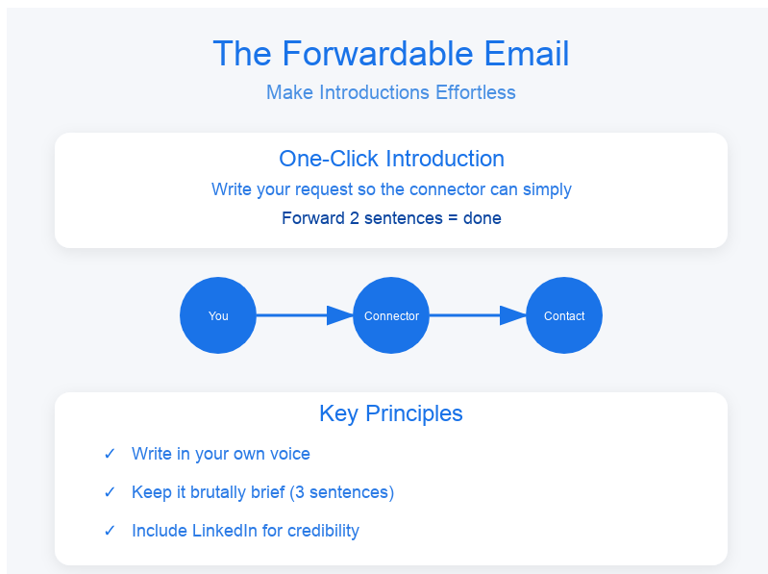

Don't feel bad if you've never heard of this. A "forwardable email" is one of those insider tactics that successful networkers use but rarely explain publicly. It's not common knowledge, and there's no reason you would automatically know the right format unless someone taught you.
But once you understand it, requesting introductions becomes dramatically more effective.
What Is a Forwardable Email?
A forwardable email is an introduction request written so efficiently that your connector can simply hit "forward," add their contact's email address, write a two-sentence note at the top, and send it off in under 30 seconds.
The entire strategy revolves around one principle: make it effortless for someone to help you.
The Golden Rule: Lower the Cognitive Burden
Throughout all effective communication, especially when asking for favors, there's one principle that matters above all else: reduce the mental effort required from the person you're asking.
It should be stupidly easy for them to say yes and follow through. Every extra second of thinking, every moment of "what do I do with this?", every ounce of confusion about next steps—all of that dramatically reduces the likelihood they'll actually help you.
The forwardable email format is brilliant because it removes nearly all friction from the process of making an introduction.
Understanding the Three Perspectives
To fully grasp why this format works, it helps to understand what each person in this chain needs:
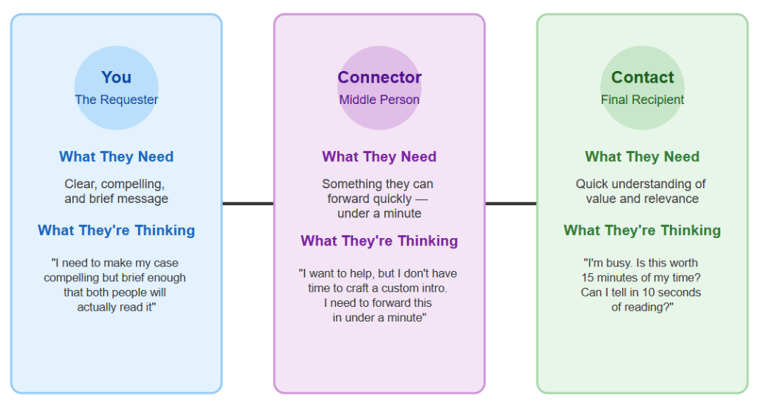

The forwardable email format works because it satisfies all three perspectives simultaneously.
Why Most People Get This Wrong
This isn't intuitive. Most people naturally write introduction requests in one of two problematic ways:
Problem #1: Writing as if you're the connector. People often draft the email from their connector's perspective, essentially writing: "Hi [Contact], I'd like to introduce you to [yourself]..." This feels helpful, but it's actually more work because the connector has to rewrite it in their own voice.
Problem #2: Presuming the introduction is done. Saying "thanks for connecting me with Sarah" assumes Sarah already agreed to meet. She hasn't. You're asking your connector to check if she's open to it.
Again, these mistakes are completely understandable. This is specialized knowledge that doesn't get taught widely.
The Right Format: Core Principles
Write in Your Own Voice
Address your connector directly and speak as yourself. You're not ghostwriting their introduction email—you're introducing yourself in a way they can easily forward.Thank Them for Checking, Not Connecting
Use language like: "Thanks so much for seeing if [name] would be open to connecting." This acknowledges the introduction hasn't happened yet.Include a Clear Credibility Statement
Make it easy for people to understand who you are. Include a short phrase explaining your role and either hyperlink your name to your LinkedIn profile or include your LinkedIn URL in your signature. This allows both your connector and the final recipient to quickly verify your background without having to ask or search.Keep It Brutally Brief
Three sentences maximum about what you're doing and why this specific connection would be valuable. That's it. If you can't explain it concisely, you're not ready to ask for the introduction.Use a Clear Subject Line
Something like: "Intro request: [Your Name] regarding [specific topic]"Make It Actually Forwardable
Your connector should be able to click forward, add their contact, type a brief note at the top, and send.
Real-World Scenario: Marcus Meets Erica
To illustrate how this works in practice, let's walk through a common situation:
Marcus, a startup founder, meets Erica, an angel investor, for coffee. During their conversation, Marcus mentions he's actively fundraising and looking to connect with investors who specialize in B2B SaaS platforms. Erica knows Sarah Chen, a venture capitalist at Acme Ventures who focuses specifically on platform investments. Erica offers to see if Sarah would be open to a conversation with Marcus.
Now Marcus needs to send Erica a forwardable email. Let's look at how most people handle this (incorrectly) versus how to do it right.
Example: What NOT to Do
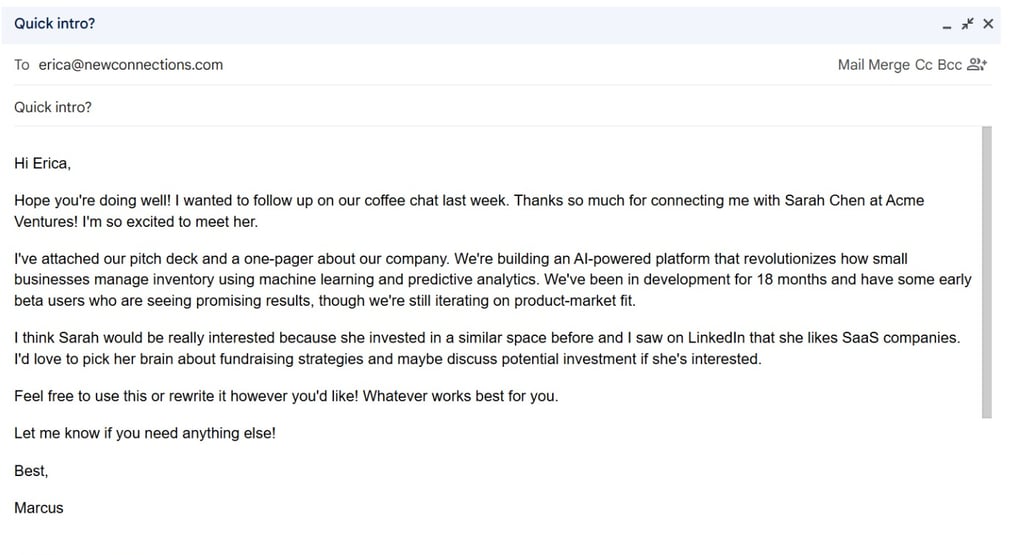

Why this fails:
Way too long (Sarah won't read all this)
Assumes the connection is already made
Vague about the actual ask
Mentions attachments (never do this in a forwardable email)
Says "feel free to rewrite" (that's extra work)
The connector has to extract the key points themselves
No easy way to verify who Marcus is
Example: What TO Do

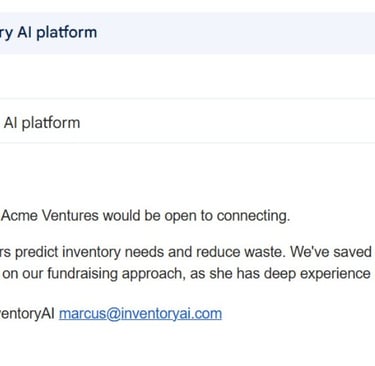
Why this works:
Short enough that Sarah will actually read it (3 sentences of substance)
Erica can forward this in 20 seconds
Acknowledges Sarah hasn't agreed yet
Specific about the value proposition and the ask
Includes contact info so Sarah can respond directly
Written in Marcus's voice, not Erica's
LinkedIn hyperlink makes it easy to verify credentials
Clear credibility statement (Founder & CEO)
If You're the Connector: How to Actually Forward It
When you receive a well-formatted forwardable email, here's exactly what to do:
Step 1: Click "Forward"
Don't start a new email. Forward the existing message so Sarah can see Marcus's words directly.
Step 2: Add Your Contact to the "To" Field
Add Sarah's email address only. Do not CC or BCC Marcus at this stage.
Important: Do not CC or BCC the requester on this initial forward. If you include them, they now have direct access to your contact before that contact has agreed to connect. This can lead to awkward situations where the requester follows up directly on the thread before your contact has responded, which undermines the introduction process. If Sarah agrees to connect, she'll reply to you, and then you can introduce them properly by CCing both parties. This can be disregarded if you have a significant amount of trust with the Requester, but it’s not otherwise recommended.
Step 3: Add a Brief Note at the Top
Write 1-3 sentences that provide context and your personal endorsement. Keep it short. You're adding credibility, not rewriting the introduction.
Good connector notes:
"Hi Sarah, met Marcus at TechCrunch last week. Sharp founder, interesting approach to retail inventory. Worth 15 minutes if you have bandwidth."
"Sarah—Marcus is in my current accelerator cohort. Solid team and real traction. Thought you two should connect."
"Hi Sarah, Marcus is a friend from grad school who's building something in your wheelhouse. Wanted to pass along. Let me know if you'd like to connect."
Notes that are too long:
Don't re-explain what Marcus already explained
Don't add extensive background about how you know Marcus
Don't write more than Marcus wrote
Step 4: Send
That's it. Total time: 30 seconds or less.
The Complete Forwarded Email Looks Like This:
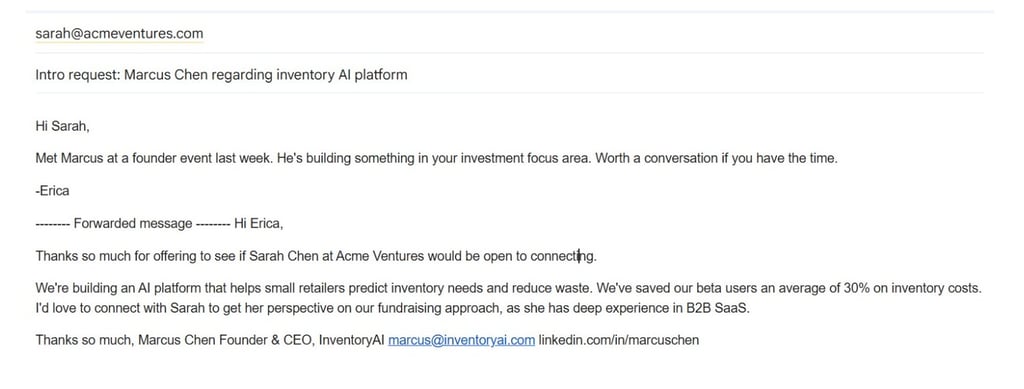

What Sarah sees: A quick endorsement from Erica (someone she trusts) followed by Marcus introducing himself in his own words. She can decide in 15 seconds whether to respond.
The Critical Rule for Connectors: Don't Send It As-Is
Never forward the email without adding your own note. If you just forward Marcus's email with no context, Sarah doesn't know:
How you know Marcus
Why you're making this introduction
Whether you're endorsing him or just passing along a request
Your brief note at the top provides the social proof and context that makes Sarah likely to respond. Without it, the introduction loses most of its value.
The Bigger Lesson
The forwardable email technique is really about understanding how to ask for help effectively. The easier you make it for someone to assist you, the more likely they are to follow through.
This principle applies far beyond email: when you're asking for feedback, requesting advice, or seeking any kind of favor, do the work to make helping you as frictionless as possible.
And remember: not knowing this format doesn't mean you've been doing networking wrong. It just means no one explained this particular technique to you—until now.
Contact


keyona@rerev.io | Birmingham, AL
